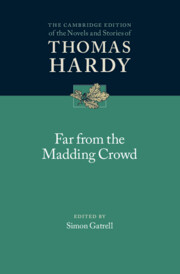3309958 results
Green Energy and Sustainable Development
- Coming soon
-
- Expected online publication date:
- August 2025
- Print publication:
- 01 May 2026
-
- Textbook
- Export citation
Nezhat's Textbook of Minimally Invasive Surgery
- Including Hysteroscopy, Vaginoscopy and Robotic-Assisted Procedures
- Coming soon
-
- Expected online publication date:
- August 2025
- Print publication:
- 31 August 2025
-
- Book
- Export citation
The Cambridge History of War
- Coming soon
-
- Expected online publication date:
- July 2025
- Print publication:
- 31 July 2025
-
- Book
- Export citation
Ways of Seeing International Organisations
- New Perspectives for International Institutional Law
- Coming soon
-
- Expected online publication date:
- July 2025
- Print publication:
- 31 July 2025
-
- Book
- Export citation
Cyril of Alexandria: Against Julian
- Introduction and Translation
- Coming soon
-
- Expected online publication date:
- July 2025
- Print publication:
- 31 July 2025
-
- Book
- Export citation
Film City Urbanism in India
- Hyderabad, from Princely City to Global City ,1890-2000
- Coming soon
-
- Expected online publication date:
- July 2025
- Print publication:
- 01 May 2026
-
- Book
- Export citation
The Ancient Scholia to Homer's Iliad
- A Translation
- Coming soon
-
- Expected online publication date:
- July 2025
- Print publication:
- 31 July 2025
-
- Book
- Export citation
Core Concepts in Criminal Law and Criminal Justice
- Volume III
- Coming soon
-
- Expected online publication date:
- July 2025
- Print publication:
- 31 July 2025
-
- Book
- Export citation
Nietzsche on the Methods and Aims of Philosophy
- The Seal of Liberation
- Coming soon
-
- Expected online publication date:
- July 2025
- Print publication:
- 31 July 2025
-
- Book
- Export citation
Advances in Material Science and Applications
- Bulk (Silicon) vs Nano (Graphene)
- Coming soon
-
- Expected online publication date:
- June 2025
- Print publication:
- 01 May 2026
-
- Book
- Export citation
Neuroscience of Attention
- Coming soon
-
- Expected online publication date:
- June 2025
- Print publication:
- 30 June 2025
-
- Book
- Export citation
The Cambridge Encyclopaedia of Late Antique Art and Archaeology
- Coming soon
-
- Expected online publication date:
- June 2025
- Print publication:
- 30 June 2025
-
- Book
- Export citation
The Cambridge Encyclopaedia of Late Antique Art and Archaeology
- Coming soon
-
- Expected online publication date:
- June 2025
- Print publication:
- 30 June 2025
-
- Book
- Export citation
The Anaesthesia Science Viva Book
- Coming soon
-
- Expected online publication date:
- June 2025
- Print publication:
- 30 June 2025
-
- Book
- Export citation
Risk Communication in Public Health Emergencies
- Practical Guidance Rooted in Theory
- Coming soon
-
- Expected online publication date:
- June 2025
- Print publication:
- 30 June 2025
-
- Book
- Export citation
Stratification Economics and Disability Justice
- Coming soon
-
- Expected online publication date:
- June 2025
- Print publication:
- 30 June 2025
-
- Book
- Export citation
The State, the Law, and the People in the Roman Empire
- A Sourcebook
- Coming soon
-
- Expected online publication date:
- June 2025
- Print publication:
- 30 June 2025
-
- Book
- Export citation
Fascism and Corporations in ‘New' India
- Coming soon
-
- Expected online publication date:
- June 2025
- Print publication:
- 01 May 2026
-
- Book
- Export citation
The Cambridge Handbook of School–University Partnerships
- Coming soon
-
- Expected online publication date:
- June 2025
- Print publication:
- 30 June 2025
-
- Book
- Export citation

Far from the Madding Crowd
- Coming soon
-
- Expected online publication date:
- June 2025
- Print publication:
- 30 June 2025
-
- Book
- Export citation

